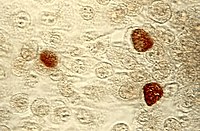
Photo from wikipedia
Abstract Chlamydia trachomatis (CT) and Neisseria gonorrhoeae (GC) are the 2 most common reported sexually transmitted infections in the United States. Current recommendations are to presumptively treat CT and/or GC… Click to show full abstract
Abstract Chlamydia trachomatis (CT) and Neisseria gonorrhoeae (GC) are the 2 most common reported sexually transmitted infections in the United States. Current recommendations are to presumptively treat CT and/or GC in persons with symptoms or known contact. This review characterizes the literature around studies with presumptive treatment, including identifying rates of presumptive treatment and overtreatment and undertreatment rates. Of the 18 articles that met our inclusion criteria, 6 pertained to outpatient settings. In the outpatient setting, presumptive treatment rates, for both asymptomatic and symptomic patients, varied from 12% to 100%, and the percent positive of those presumptively treated ranged from 25% to 46%. Three studies also reported data on positive results in patients not presumptively treated, which ranged from 2% to 9%. Two studies reported median follow-up time for untreated, which was roughly 9 days. The remaining 12 articles pertained to the emergency setting where presumptive treatment rates, for both asymptomatic and symptomic patients, varied from 16% to 91%, the percent positive following presumptive treatment ranged from 14% to 59%. Positive results without presumptive treatment ranged from 4% to 52%. Two studies reported the percent positive without any treatment (6% and 32%, respectively) and one reported follow-up time for untreated infections (median, 4.8 days). Rates of presumptive treatment, as well as rates of overtreatment or undertreatment vary widely across studies and within care settings. Given the large variability in presumptive treatment, the focus on urban settings, and minimal focus on social determinants of health, additional studies are needed to guide treatment practices for CT and GC in outpatient and emergency settings.
Journal Title: Sexually Transmitted Diseases
Year Published: 2022
Link to full text (if available)
Share on Social Media: Sign Up to like & get
recommendations!